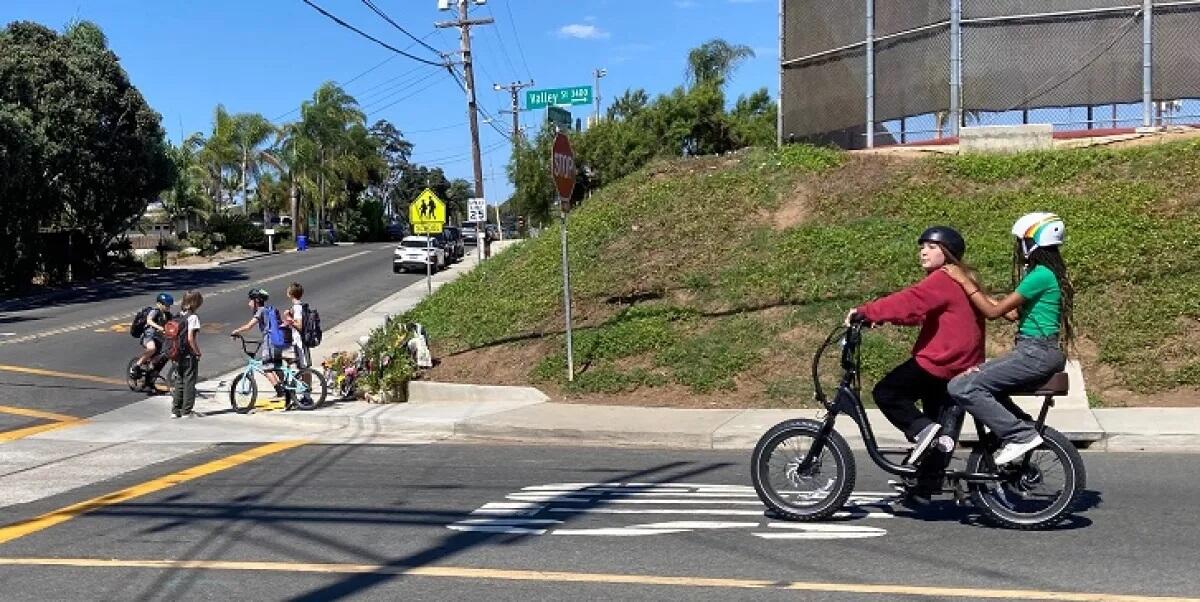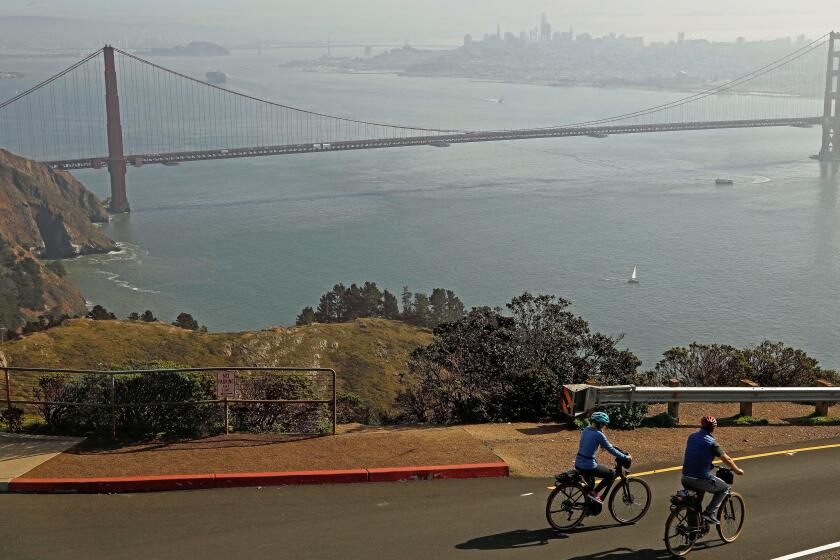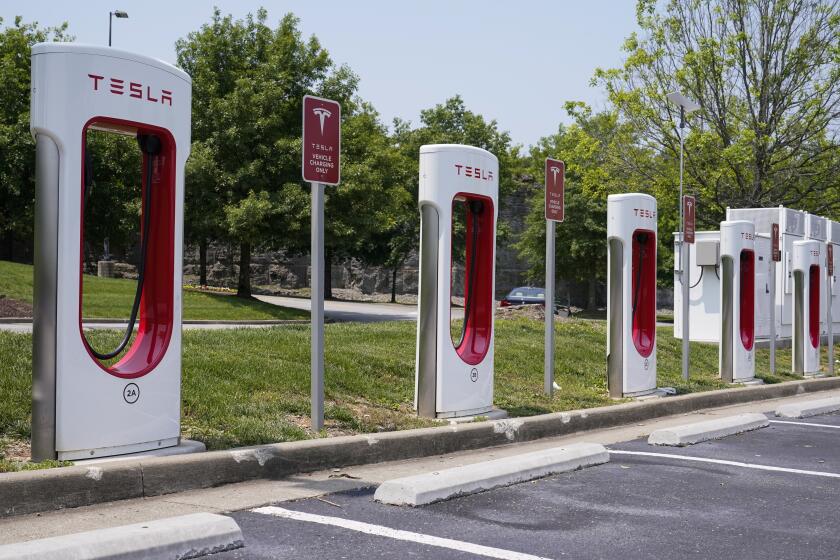E-bike programs and other green transit efforts are sprouting throughout the state. Will they catch on?

Long Beach aims to launch an e-bike lending program to provide residents with up to 40 bikes in one of the latest efforts in California to increase accessibility with green transportation.
The city is seeking a vendor to provide standard, cargo and tricycle e-bikes and equipment including helmets and locks. The program, which is expected to start before the end of the year, will allow residents to check out the electric vehicles for up to three months at no cost.
âCycling removes us from our bubbles and brings us into more human contact and connection,â said Reed Sherlock, a transportation planner overseeing the Long Beach pilot.
The effort reflects a surge in state and municipal programs to provide environmentally friendly modes of travel, including e-bikes, electric cars and zero-emission buses. The programs are intended to improve local transportation without adding to the emissions and noise generated by gas-guzzling cars and buses.
E-bike sales across the country have increased in the last several years, with many consumers choosing them as an eco-friendly alternative to driving without the hassle of finding parking.
But in at least one city, the increase in e-bike riders has led to a rise in bike accidents, prompting local authorities to crack down on motorists who ignore safe-driving rules around bicyclists.
Experts also say that although owning an e-bike is significantly less expensive than owning a car, the bikes are not cheap, requiring an investment of a couple of thousands of dollars.
In Long Beach, officials said the e-bike library program will increase familiarity and ridership of this zero-emission form of traveling. The bicycles are equipped with fully operable pedals and an electric motor for a boost. The cargo models include extra seats for children and space for groceries.
âBicycling is a public good,â Sherlock said. âLike access to books through libraries, bicycling can empower communities, regardless of age, and provide more possibilities for access to transportation.â
Long Beach will reserve two-thirds of the bikes for residents enrolled in income assistance programs who âjust donât have the financial capability to have a car as their primary mode of transportation,â Sherlock said.
Cycling removes us from our bubbles and brings us into more human contact and connection.
— Reed Sherlock, Long Beach transportation planner
The California Air Resources Board plans to launch an e-bike incentive program this fall in response to growing interest across the state. The program will target low-income residents and those who live in disadvantaged communities, and will offer rebates of $1,000 off a standard e-bike, with an additional $750 discount for larger bikes.
E-bike pilot programs like this have cropped up in cities across the state. Pasadena launched one in July that will provide rebates of $500 to $1,000 for residents who purchase an e-bike in the city. In Berkeley, more than 600 low-income residents applied to be part of an e-bike lottery program this year. The project provided 56 households with bikes to use through next May.
âThere is way more demand for this among low-income people than thereâs funding,â said Laura McCamy, a communications specialist at the California Bicycle Coalition. âE-bikes provide critical transportation in places that are transit deserts, often poor or underserved suburban neighborhoods.â
McCamy predicts that as more people ride bikes, vehicle drivers will become more likely to share the road with cyclists.
Itâs difficult to stay current on the regulations governing e-bikes in national and state parks. How do you know? Ask lots and lots of questions.
But some cyclists are wary about sharing the road with cars.
Encinitas in San Diego County declared a local state of emergency after a 15-year-old boy riding an e-bike was killed in a crash in late June. The city also launched a public education campaign that includes coordinating with school districts and private schools to relay traffic safety messages and add electronic messaging boards at high collision and traffic areas.
âIt is the type of tragedy that makes you sit up in your chair and recognize that we need to do more,â Encinitas Mayor Tony Kranz said.
The emergency proclamation will expedite city measures to protect the bike-riding community, especially during the busy summer season, Kranz said. It is expected to end on Sept. 30.
One of those measures, enacted Friday, prohibits a person from riding a bicycle in a manner unintended for its design, such as sitting on it backward. First-time violators can waive penalties if they take a bike safety course.
In Encinitas, collisions involving bicycles or e-bikes tripled since 2020, with 11 crashes already reported this year, city officials said. Bike incidents occurred more frequently in the summer months.
The proclamation notes that e-bikes, which are faster and heavier, can cause more severe damage than regular bikes in collisions. But Kranz believes itâs worthwhile to continue supporting all cycling and greener transportation alternatives.
âIn a city like Encinitas, where the weather is very favorable for riding a bike, it just makes a whole bunch of sense,â Kranz said. âOur roadways are designed for the automobile, and we need to make some changes to increase mobility options.â
Bicycling does make sense, considering that more than half of all daily vehicle trips across the country, including car, rail, transit and air travel, were less than three miles in 2021, and almost a third were less than a mile, according to the Bureau of Transportation Statistics.
The money will go for clean energy projects such as residential heat pumps, electric vehicle charging stations and community cooling centers.
Long Beach is not the only city trying to provide a creative green transportation alternative.
Sacramento officials launched a micro-transit service called SmaRT Ride in 2018 to better serve people living in suburban communities. Riders can request a shuttle to pick them up and drop them off âcorner-to-cornerâ via a smartphone app. A study by the Institute of Transportation Studies at UC Davis found that more than half of the users were low-income residents and were more likely to have physical limitations.
Affordable housing complexes in Tulare and Kern counties began in 2019 hosting vehicle hubs for Miocar, an electric car-sharing program designed to improve transportation in the rural San Joaquin Valley.
San Francisco has Californiaâs largest zero-emission bus fleet and has among the lowest emissions per passenger in the state, according to a 2021 study by the U.S. Department of Transportation.
Across the bridge, officials in East Oakland launched a universal basic mobility pilot that provided some residents with funds for public transit and shared mobility services, such as e-scooters. About 1,000 residents in West Oakland will be eligible to receive up to $320 to use toward transportation in the fall.
McCamy is cautiously optimistic about the new sustainable efforts across the state.
âI think it could be revolutionary,â she said. âIâm not saying it would be cheap or easy â it would take a concerted effort â but it is very achievable.â
More to Read
Sign up for Essential California
The most important California stories and recommendations in your inbox every morning.
You may occasionally receive promotional content from the Los Angeles Times.













